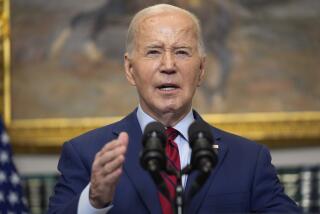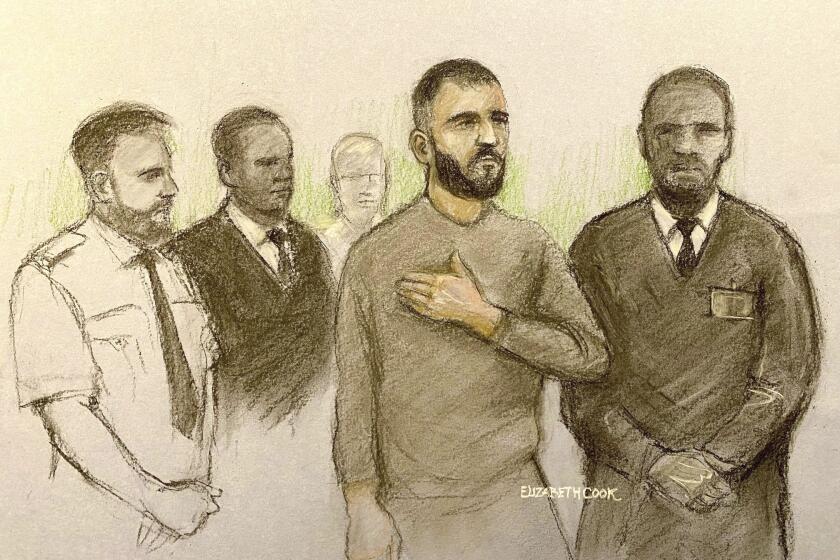Oklahoma twister ‘was a monster’
Rescuers sifted through debris in a desperate search for survivors Monday night after a massive tornado battered the Oklahoma City area, killing at least 51 people, including 20 children, and injuring 120. The toll was expected to rise.
With 200-mph winds, the twister shredded highways, mangled and flipped cars and trucks, smashed into two elementary schools and reduced neighborhoods to rubble.
“As we know today, we’ve had a massive tornado -- a huge one -- that’s passed through this community,” Gov. Mary Fallin said in a news conference. “We do know there are fatalities. ... We know there are a lot of injuries. We know we’ve lost a tremendous amount of structures throughout this community and throughout the state.”
She pledged that rescuers would look “under every single piece of debris.”
“Our hearts are broken for the parents that are wondering about the state of their children that had been in the schools that have been hit today,” Fallin said.
Plaza Towers Elementary School in the suburb of Moore was destroyed, and Briarwood Elementary School in Oklahoma City was heavily damaged. Everyone at Briarwood was safe, but rescue work at Plaza Towers continued into the night. Dozens of children were among the missing.
Rescuers extricated survivors and passed them down a human chain to a triage center in a parking lot. As jackhammers tore away the concrete, people crawled over the ruins, searching for survivors.
Anxious parents waited near a Catholic church Monday night as a man with a megaphone called out the names of surviving children.
The devastating tornado came a day after several twisters tore through rural areas of Oklahoma and Kansas, killing two people in a mobile home park in Shawnee, Okla. Fallin had signed a federal emergency declaration Sunday for 16 counties, and Monday she said she had added five more.
President Obama signed a major disaster declaration and offered Fallin federal support, the White House said.
The twister that hit Moore, a suburb of 55,000 about 11 miles south of Oklahoma City, touched down just before 3 p.m. It raged on the ground for 40 minutes over a 20-mile path with winds up to 200 mph, the National Weather Service said. That would make it a category 4, perhaps even a 5 on the Enhanced Fujita scale. Researchers will update the data after canvassing the area.
“This one was a monster. It was huge, dark and scary. It was just this big, dark menacing act of nature coming toward you,” said Julie Jones, 54, who lives in Moore and fled the tornado in her car, like many neighbors in her cul-de-sac.
The twister moved across highways, including Interstate 35, causing huge traffic jams as people tried to flee.
“We could see the tornado in the rearview mirror getting closer, closer and closer, and we’re stopped in traffic,” Jones said.
She eventually dodged the tornado and paused, with others, atop a hill to watch it cut through town. When she got home, her house was untouched, but nearby areas were leveled.
“The most terrifying thing was returning to the neighborhood and seeing what it did,” Jones said. “You’re driving past the homes and you think, ‘That person had a great house and that person kept their lawn beautiful,’ and it doesn’t matter because they were all flattened. It shakes you.”
Tornado sirens saved some lives, sounding 30 minutes before touchdown. With the warning, Moore Medical Center -- part of the Norman Regional Medical Center -- moved 30 patients to a bottom floor. They were all safe.
“We had a direct hit from the tornado that pretty much demolished the second floor of the hospital,” said Kelly Wells, a spokeswoman for Norman Regional Medical Center.
The city of Moore kept children at school so they could shelter in place with teachers rather than go home alone, city spokesman Jayme Shelton said.
Edie Cordray spent the day praying for her best friend, Becky Jo Evans, a first-grade teacher at Plaza Towers who survived the storm. Evans pulled some of her students into a bathroom when the tornado hit, Cordray said, and covered the children with her body as the walls fell in.
Evans doesn’t know how many of the children survived, Cordray said. “There’s still a lot of confusion on where the kids are.”
Hospital officials said they had treated about 120 people, including 50 children.
The devastation brought veteran reporters to the verge of tears. Lance West of KFOR-TV, an NBC affiliate in Oklahoma City, said on TV that he had interviewed a man pulling third-graders out of the school.
“I’ve never seen anything like this in my 18 years covering tornadoes here in Oklahoma City,” he said, his voice breaking. “This is without question the most horrific I’ve ever seen.”
Emergency responders from around the state have been called. Authorities called in 80 National Guardsmen to secure perimeters and used rescue dogs to search for survivors.
Brent Akin, who works for an oil and gas valve manufacturing company, brought heavy equipment to help remove debris.
“I think the first thing most people did was make sure their homes and families were OK and then volunteered to do what they could,” said Jezire Hudson, Akin’s fiancee.
Residents were comparing Monday’s twister to the most powerful tornado ever recorded, which struck the area on May 3, 1999, with 300-mph winds, killing 44.
Monday’s storm had a preliminary rank of 4 on the Enhanced Fujita scale. At that level, well-constructed houses are leveled, weak structures are blown away and large missiles are generated. A storm rated 5 will have “incredible phenomena,” with strong frame houses swept away and automobile-sized missiles flying more than 100 yards, according to the National Weather Service.
Those who survived felt grateful. James Dock rode out the storm in a movie theater that was showing “Star Trek Into Darkness.”
The film had just started when phones started buzzing with weather alerts, Dock said. They were evacuated to the hallway, and then the power went out.
Soon, the air pressure dropped, and a theater employee shouted for everyone to get against the wall and put their heads down.
“There was a great kind of roaring sound, and the ground started shaking, making everything else start shaking,” Dock said.
When he went outside, he saw the destruction. The marquee of the theater had been torn off, mud and debris were everywhere, and broken glass littered the ground. A nearby bowling alley was gone, and a car was sticking out of the Moore Medical Center. Dock’s car window had been smashed by a piece of wood.
“Now that I have seen what almost hit us, I feel extremely lucky to be alive,” he said. “I feel numb.”
--
hector.becerra@latimes.com
julie.cart@latimes.com
Times staff writers Alana Semuels in Los Angeles and Kathleen Hennessey in Washington and the Associated Press contributed to this report.
More to Read
Start your day right
Sign up for Essential California for news, features and recommendations from the L.A. Times and beyond in your inbox six days a week.
You may occasionally receive promotional content from the Los Angeles Times.







